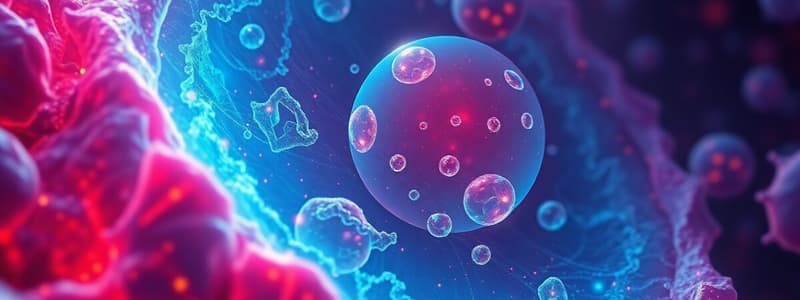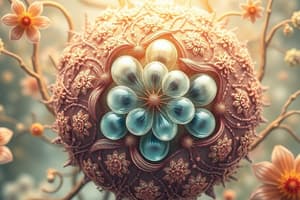Podcast
Questions and Answers
Flashcards
Prokaryotic cell
Prokaryotic cell
A cell without a nucleus or other membrane-bound organelles. Includes bacteria and archaea.
Eukaryotic cell
Eukaryotic cell
A cell with a nucleus and other membrane-bound organelles. Includes animals, plants, fungi, and protists.
Flagella
Flagella
Whip-like appendages used for bacterial movement.
Monotrichous flagella
Monotrichous flagella
Signup and view all the flashcards
Lophotrichous flagella
Lophotrichous flagella
Signup and view all the flashcards
Amphitrichous flagella
Amphitrichous flagella
Signup and view all the flashcards
Peritrichous flagella
Peritrichous flagella
Signup and view all the flashcards
Chemotaxis
Chemotaxis
Signup and view all the flashcards
Phototaxis
Phototaxis
Signup and view all the flashcards
Fimbriae
Fimbriae
Signup and view all the flashcards
Pili
Pili
Signup and view all the flashcards
Glycocalyx
Glycocalyx
Signup and view all the flashcards
Slime layer
Slime layer
Signup and view all the flashcards
Capsule
Capsule
Signup and view all the flashcards
Gram-positive bacteria
Gram-positive bacteria
Signup and view all the flashcards
Gram-negative bacteria
Gram-negative bacteria
Signup and view all the flashcards
Peptidoglycan
Peptidoglycan
Signup and view all the flashcards
Nucleoid
Nucleoid
Signup and view all the flashcards
Plasmids
Plasmids
Signup and view all the flashcards
Ribosomes (70S)
Ribosomes (70S)
Signup and view all the flashcards
Endospores
Endospores
Signup and view all the flashcards
Coccus
Coccus
Signup and view all the flashcards
Bacillus
Bacillus
Signup and view all the flashcards
Virus
Virus
Signup and view all the flashcards
Capsids
Capsids
Signup and view all the flashcards
Study Notes
Cell Characteristics
- All living things are composed of cells with various shapes, including spherical, cubical, and cylindrical.
- Cytoplasm is enclosed by a membrane.
- Cells contain DNA, chromosomes, and ribosomes.
- Cells have metabolic capabilities.
- Two main cell types exist: prokaryotic (bacteria and archaea) and eukaryotic (animals, plants, fungi, and protists).
External Cell Structures
- Flagella: Have a filament, hook, and basal body. Flagella are made of flagellin protein and aid in movement(clockwise rotation causes tumbling, counter-clockwise allows for smooth motion).
- Arrangements: Exist in different arrangements, such as monotrichous (single flagellum), lophotrichous (flagella bundles), amphitrichous (flagella at both ends), and peritrichous (flagella across the cell surface).
- Fimbriae: Fine protein bristles used for cell adhesion.
- Pili: Rigid tubes found in gram-negative bacteria; enables DNA transfer (conjugation).
- Glycocalyx: External coating made of sugars and proteins. Types include slime layer (loosely organized) and capsule (tightly organized). This coating provides protection and assists in biofilm formation.
Cell Envelope and Wall Structure
- Gram-Positive Bacteria: Possess a thick peptidoglycan layer (20-80 nm thick), contains teichoic and lipoteichoic acids. Their cell walls are more permeable.
- Gram-Negative Bacteria: Have a thinner peptidoglycan layer and a double membrane structure. Contain lipopolysaccharides (LPS).
Internal Cell Structures
- Nucleoid: Contains a single circular DNA chromosome which is not essential for bacterial growth.
- Plasmids: Small circular extrachromosomal DNA molecules, not essential for bacterial growth.
- Ribosomes: Made of 60% RNA and 40% proteins and are the site of protein synthesis. (70S type).
- Storage Structures/inclusions: Inclusions and granules for nutrient storage (endospores).
Major Taxonomic Groups
- Domain Archaea: Adapted to extreme environments, characterized by unique membrane lipids and cell walls. Includes three main phyla.
- Domain Bacteria: Includes proteobacteria (gram-negative), firmicutes (mostly gram-positive, low G+C content), and actinobacteria (gram-positive, high G+C content).
Viruses
- Viruses are obligate intracellular parasites requiring host cells for reproduction.
- Fundamental characteristics include size (20-450 nanometers), lack of cellular structure, and protein shell (capsid) and nucleic acids (DNA or RNA).
- They multiply by taking over the host cells' genetic machinery. Viruses are greatly diverse in their shapes.
Viral Structure
- Capsids: Two main types:
- Helical: cylindrical shape
- Icosahedral: 20-sided
- Envelopes: Present in some animal viruses.
General Phases of Viral Multiplication
- Adsorption
- Penetration
- Uncoating
- Synthesis
- Assembly
- Release
Effects on Host Cells
- Some viruses cause cytopathic effects, such as changes in cell shape and formation of inclusion bodies.
- Others cause persistent infections or cancer.
Viral Genetics
- Viral genomes may be DNA or RNA.
- Replication varies depending on the virus type (whether DNA or RNA).
Bacterial Classification
- Basic bacterial cell shapes: coccus, bacillus, spirillum, vibrio, and spirochete.
- Major taxonomic groups: Domain Archaea and Domain Bacteria.
Studying That Suits You
Use AI to generate personalized quizzes and flashcards to suit your learning preferences.




